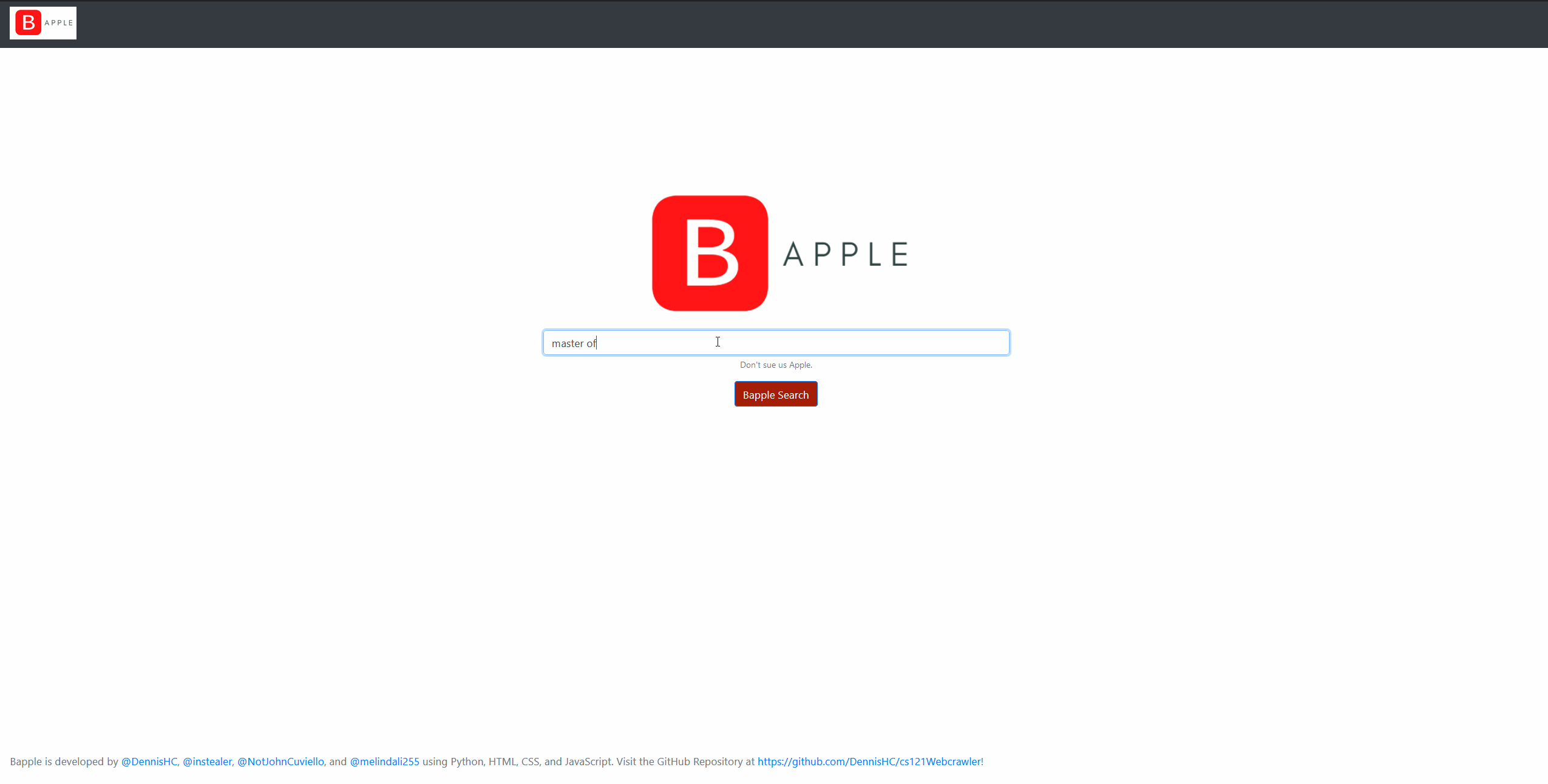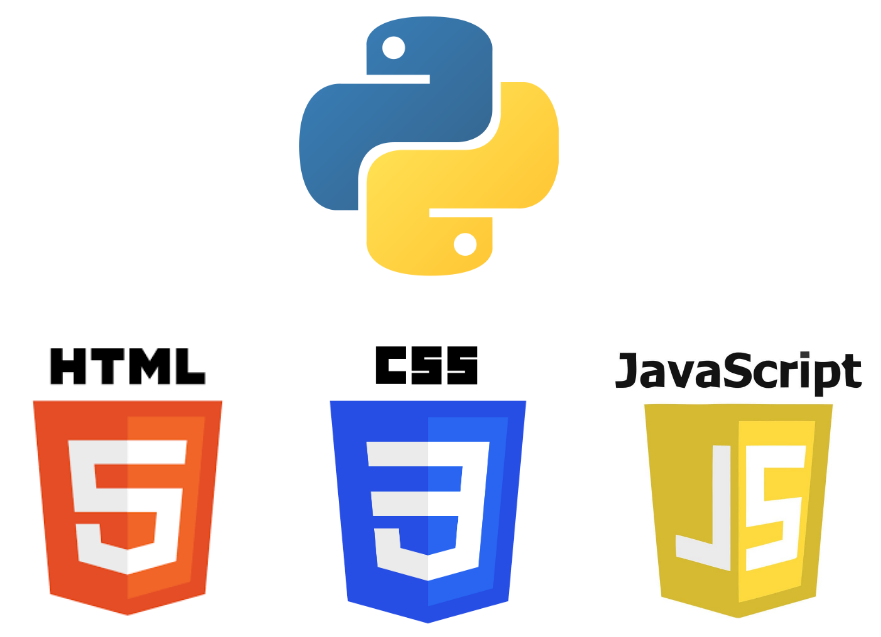CS 121 Project – Bapple
Introduction
Bapple is a search engine created by Dennis Chuong, Dennis Hernandez, John Cuviello, and Melinda Li for
COMPSCI 121: Information Retrieval, an upper division class offered at UC Irvine. Over the course of four weeks,
we developed a search engine from scratch using Python and a clean user interface with HTML, CSS, Bootstrap, and JavaScript.
Our group was recognized for having the best user interface this quarter.
Given a set of JSON files containing a website’s HTML, Bapple is able to store and index the terms locally to be
used during the querying process. Once a user submits a query, Bapple can quickly provide an ordered list of relevant websites,
usually in under 300 milliseconds.

Objective
The objective for the project was to create a robust search engine,
consisting of both an indexer and search component, for webpages under the uci.edu domain.
The primary goal for our search engine was to retrieve documents both effectively and
efficiently, by providing the most relevant documents and retrieving the respective
documents in 300 milliseconds or less. We planned to achieve this by creating an inverted
index for the terms in our corpus while utilizing a tokenizer, token stemming,
and weighting of important text. We also planned to implement query processing
at retrieval time which included ranking based on tf-idf score along with term weight
based on html tags. Additional features we had initially planned to implement included
an aesthetic web interface, similar/duplicate page detection, and bigram indexing.
System Architecture
The user interface of Bapple was implemented in HTML, CSS, Bootstrap, and JavaScript.
The back-end of the project was constructed in Flask. We imported the logic for our
search engine through our app.py (Flask) file before passing the information to the
front-end application.
The user search queries are retrieved from the search bar asynchronously and are appended
to the URL in order for it to be used again on the results page, where we displayed the
relevant results of the search query. The user search query is processed through our Python
functions we had coded using principles such as stemming words and ranking words based on
tf-idf score. Our search engine would return a fixed number of top results relevant to the
search query, in which we would pass as context objects to the front-end to manipulate with
HTML, CSS, and JavaScript. The titles and URLs of the webpages are displayed functionally
on the results page, in which the user can click on the hyperlinks to directly access the
page.

Work Distribution
Dennis Chuong
- Implemented an interactive, web-based user interface using HTML,
CSS, Bootstrap, and JavaScript
- Utilized Flask to handle search engine logic and pass top-ranking
search queries to the front-end by context objects
- Designed algorithm to merge partial indexes that resulted from the inverted
index being separated into three separate documents
Dennis Hernandez
- Traversed folder/files to gather the webpage files for later opening and processing
- Computed tf-idf scores for each term in the corpus to use in the ranking implementation
- Implemented simhash for similarity and duplicate checking of web pages
- Store number of times a certain term appears in important tags to weigh the
website in the ranking algorithm
John Cuviello
- Implemented conjunctive processing for query terms, with rankings based
on tf-idf score and weight of important html tags
- Created intersection algorithm for document ids to find overlapping
documents for a given token
Melinda Li
- Stored inverted index into three separate documents to preserve local memory space
- Created a dictionary to track the byte location of each term in the inverted index file
- Implemented bigram storage and usage to quickly retrieve results for two word queries
Challenges/Roadblocks
A major challenge in this project was figuring out what specifically to code,
since the requirements were designed to be vague and up for interpretation in
this course. We knew the general idea behind the project, but when getting into
the details, we were not too sure about how to modularize or split up the functionality.
Interfacing with code was dependent on how it ended up being implemented. Since we
didn’t know how things would be implemented in the beginning, we were stuck at times
waiting for other parts to be finished.
Another issue we ran into was persisting the index data for efficient use.
We originally persisted the data using Python pickling, but this presented
difficulties when trying to read off the file at query time. The pickled data
was dependent on knowing the custom class definitions and wasn’t able to utilize
file seek. We resolved this issue by storing the index as text in json format.
This text was easier to read and parse back into a Python dictionary.
Even though this data was able to be read back into a Python dictionary,
we ran into memory problems. This brings us to our next issue.
Reading only the data we need at a time into memory. To be able to find this data
quickly, we built an index of the index. This secondary index provided the file
positions necessary to find the correct terms and their Postings List quickly.
Future Work
If we had more time, we would add cosine similarity to improve the ranking of
relevant documents. We were also planning on implementing a champions list of
documents, which would help ensure only the highest ranked documents would be
retrieved, letting us skip over less relevant ones. We would also order the posting
objects in the inverted index by TF-IDF and HTML tags to save time from ranking
them during query time. To further improve the ranking of relevant documents, we
would implement the use of word positions to ensure that phrases in the query closely
match queries in relevant documents.
Conclusion
Through this course, we learned how to apply fundamental information retrieval
concepts to build a search engine efficient in regards to both space and time,
while strengthening our abilities working in a team environment. By completing
all of the required features early on, we were able to focus on more interesting
and challenging concepts to add to the search engine that were optional features.
This included creating a graphical user interface, handling bigrams, and detecting
duplicate and similar pages. After implementing all of our optional features, we
were able to retrieve the most relevant documents for a given query in under 300
milliseconds. The results from the queries were proven to have high precision and
recall. Additionally, we were recognized as having constructed the best user interface
in the course this quarter and we received a score of 60/55 on the assignment.

